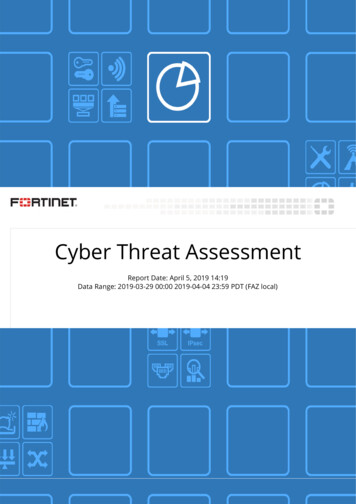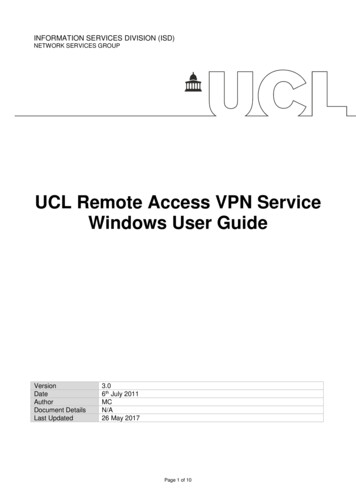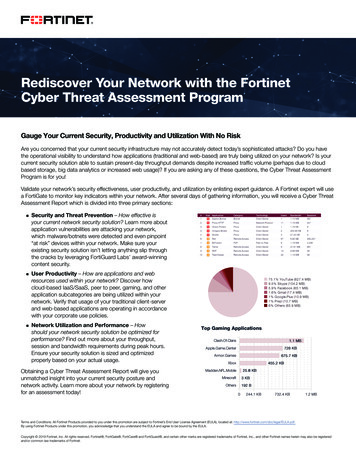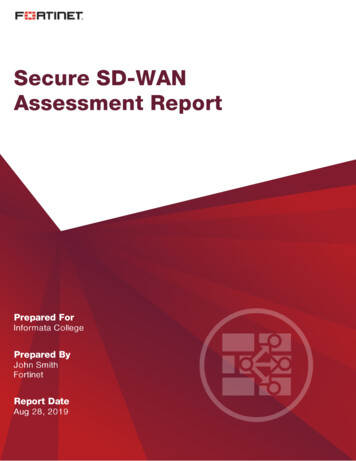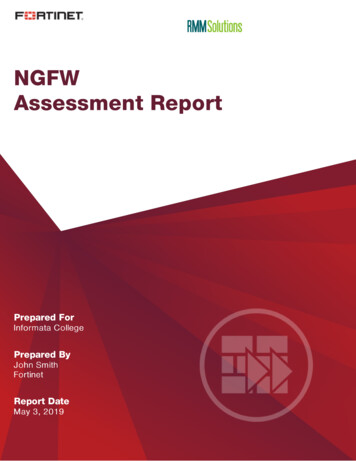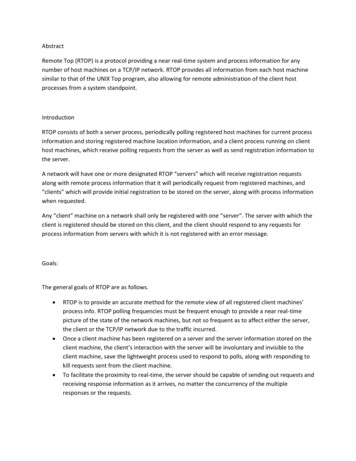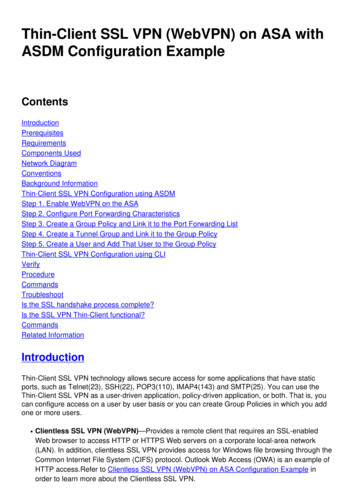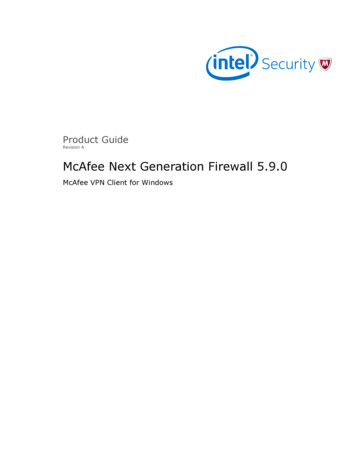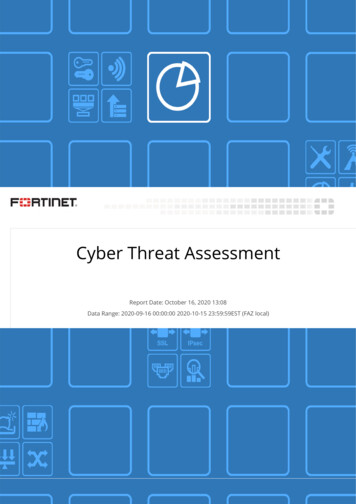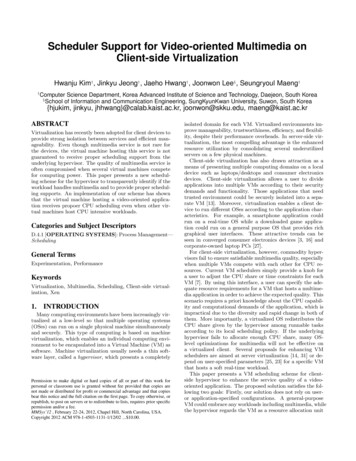
Transcription
Scheduler Support for Video-oriented Multimedia onClient-side VirtualizationHwanju Kim† , Jinkyu Jeong† , Jaeho Hwang† , Joonwon Lee§ , Seungryoul Maeng††Computer Science Department, Korea Advanced Institute of Science and Technology, Daejeon, South Korea§School of Information and Communication Engineering, SungKyunKwan University, Suwon, South Korea{hjukim, jinkyu, jhhwang}@calab.kaist.ac.kr, joonwon@skku.edu, maeng@kaist.ac.krABSTRACTVirtualization has recently been adopted for client devices toprovide strong isolation between services and efficient manageability. Even though multimedia service is not rare forthe devices, the virtual machine hosting this service is notguaranteed to receive proper scheduling support from theunderlying hypervisor. The quality of multimedia service isoften compromised when several virtual machines competefor computing power. This paper presents a new scheduling scheme for the hypervisor to transparently identify if theworkload handles multimedia and to provide proper scheduling supports. An implementation of our scheme has shownthat the virtual machine hosting a video-oriented application receives propoer CPU scheduling even when other virtual machines host CPU intensive workloads.Categories and Subject DescriptorsD.4.1 [OPERATING SYSTEMS]: Process Management—SchedulingGeneral TermsExperimentation, PerformanceKeywordsVirtualization, Multimedia, Scheduling, Client-side virtualization, Xen1.INTRODUCTIONMany computing environments have been increasingly virtualized at a low-level so that multiple operating systems(OSes) can run on a single physical machine simultaneouslyand securely. This type of computing is based on machinevirtualization, which enables an individual computing environment to be encapsulated into a Virtual Machine (VM) assoftware. Machine virtualization usually needs a thin software layer, called a hypervisor, which presents a completelyPermission to make digital or hard copies of all or part of this work forpersonal or classroom use is granted without fee provided that copies arenot made or distributed for profit or commercial advantage and that copiesbear this notice and the full citation on the first page. To copy otherwise, orrepublish, to post on servers or to redistribute to lists, requires prior specificpermission and/or a fee.MMSys’12 , February 22-24, 2012, Chapel Hill, North Carolina, USA.Copyright 2012 ACM 978-1-4503-1131-1/12/02 . 10.00.isolated domain for each VM. Virtualized environments improve manageability, trustworthiness, efficiency, and flexibility, despite their performance overheads. In server-side virtualization, the most compelling advantage is the enhancedresource utilization by consolidating several underutilizedservers on a few physical machines.Client-side virtualization has also drawn attraction as ameans of presenting multiple computing domains on a localdevice such as laptops/desktops and consumer electronicsdevices. Client-side virtualization allows a user to divideapplications into multiple VMs according to their securitydemands and functionality. Those applications that needtrusted environment could be securely isolated into a separate VM [13]. Moreover, virtualization enables a client device to run different OSes according to the application characteristics. For example, a smartphone application couldrun on a real-time OS while a downloaded game application could run on a general purpose OS that provides richgraphical user interfaces. These attractive trends can beseen in converged consumer electronics devices [3, 16] andcorporate-owned laptop PCs [27].For client-side virtualization, however, commodity hypervisors fail to ensure satisfiable multimedia quality, especiallywhen multiple VMs compete with each other for CPU resources. Current VM schedulers simply provide a knob fora user to adjust the CPU share or time constraints for eachVM [7]. By using this interface, a user can specify the adequate resource requirements for a VM that hosts a multimedia application in order to achieve the expected quality. Thisscenario requires a priori knowledge about the CPU capability and computational demands of the application, which isimpractical due to the diversity and rapid change in both ofthem. More importantly, a virtualized OS redistributes theCPU share given by the hypervisor among runnable tasksaccording to its local scheduling policy. If the underlyinghypervisor fails to allocate enough CPU share, many OSlevel optimizations for multimedia will not be effective ona virtualized client. Several proposals for enhancing VMschedulers are aimed at server virtualization [14, 31] or depend on user-specified parameters [25, 23] for a specific VMthat hosts a soft real-time workload.This paper presents a VM scheduling scheme for clientside hypervisor to enhance the service quality of a videooriented application. The proposed solution satisfies the following two goals: Firstly, our solution does not rely on useror application-specified configurations. A general-purposeVM could embrace any workloads including multimedia, whilethe hypervisor regards the VM as a resource allocation unit
without any knowledge about the tasks running on the VM.Therefore, it is hard for the hypervisor to decide how muchCPU is allocated to a VM even when a user knows the exact demands for the desired multimedia quality. Secondly,our scheme is aimed at a hypervisor-based solution withoutOS cooperation. Since a hypervisor can host diverse OSes,OS involvement makes deployment cumbersome, because itrequires modifications to each hosted OS.Our proposed solution transparently estimates multimedia quality and dynamically adjusts CPU allocation basedon the estimates as feedback. To this end, we consider adisplay rate (i.e., frame rate) as a metric for evaluating multimedia quality that is sensitive to human vision [11]. Forhypervisor-level estimation, a display rate is derived fromlow-level events that can be transparently monitored by thehypervisor without OS involvement. The estimated quality is used for the hypervisor to adjust CPU allocation. Thefeedback-driven CPU allocator, named multimedia manager,cooperates with a VM scheduler to meet desired multimediaquality by adapting CPU share on the fly.In order to evaluate the proposed scheme, we implement aXen-based prototype that incorporates the multimedia manager and the Credit scheduler, which is a proportional sharescheduler included in Xen by default. The actual adjustment of the CPU share and a refined preemption schemefor achieving responsiveness are implemented in the Creditscheduler, while the rest of our scheme is scheduler-independentto ensure compatibility with other VM schedulers. Videoplayback and 3D gaming are selected as CPU-intensive multimedia workloads with which various synthetic and realworkloads compete for CPU resources. The experimentalresults show that our scheme effectively supports multimedia workloads in dealing with heavy CPU contention.The rest of this paper is organized as follows: As background information, Section 2 describes usage scenarios ofclient-side virtualization and I/O virtualization mechanisms.Section 3 describes related work and our motivation. In Section 4, we present the preliminary analysis of the Xen Creditscheduler for multimedia workloads. Section 5 introducesour proposed scheme and Section 6 presents the evaluationresults. Finally, Section 7 draws conclusions and suggestsfuture direction for our research.2.CLIENT-SIDE VIRTUALIZATIONDesktop virtualization is introduced for flexible and secure management of desktop environments. Virtual desktopcomputing can be realized by server-side and client-side virtualization. Server-side virtual desktop computing, calledVirtual Desktop Infrastructure (VDI), pushes virtual desktops into centralized server farm, to which each user connects via network; this model matches thin client computing.In this model, user experience tightly depends on networkbandwidth and remote desktop protocols. In order to improve user experience, VDI solutions provide multimediaenhanced remote desktop protocols, which offload mediaprocessing to client devices for reducing network bandwidth.In spite of such improvement, server-side VDI cannot alwaysguarantee desktop availability for mobile users who may bedisconnected from the central server.Client-side virtualization enables offline (disconnected) VDIby allowing users to run virtual desktops on their local clientdevices. Since a desktop environment is entirely confinedin a local device, client-side virtualization provides muchbetter user experience and availability, regardless of network status, compared to server-side approaches. Clientside virtualization can still use a centrally managed VMby checking out the VM image from a management serverto a local device if necessary. For this type of virtualization, many vendors provide various client-side solutions inthe form of bare-metal hypervisors (e.g., Citrix XenClient,VMware CVP, and Virtual Computer NxTop) and hostedhypervisors (e.g., VMware ACE, MVP, and Workstation) 1 .This section describes usage scenarios of client-side virtualization and hosted I/O virtualization.2.1 Usage Scenarios2.1.1 Mobile LaptopsMany people use their laptops both for personal purposesand for business tasks. In this case, corporate informationcan be easily leaked by a malicious attack or virus, whichmay have penetrated the system via less secure personalapplications. In order to address this problem, corporateadministrators may confine sensitive information to securelyisolated facilities, but the weak isolation between personaland corporate environments on a laptop makes it difficult tocompletely protect the information.Client-side virtualization offers complete isolation betweenbusiness and personal environments, enabling a user to securely accommodate both on a single laptop. Citrix XenClient [27] manages a business VM as a secure domain whileallowing private extensions in a personal VM. Likewise, theVMware MVP enables employee-owned devices to securelyisolate corporate profiles from personal ones.2.1.2 Converged Consumer Electronics DevicesConsumer electronics devices have converged because ofthe increase in their computational power, memory, andstorage capacity. A smartphone, for example, has integratedmultiple functions such as PC-like tasks (e.g., Flash playingand downloading via Wi-Fi) with its primary functions, i.e.,calling and texting. This trend enables a device user to freelyextend the functionality by downloading 3rd-party applications via an online store (e.g., AppStore). In this type ofdevices, their primary functions must be safely protectedfrom malicious applications, because malfunctions of majorcomponents would lead to recalls of the devices.For the trustworthiness of extensible consumer electronicsdevices, client-side virtualization provides strong isolation ofthe intrinsic components from other foreign software components [13]. Virtualization also allows a real-time OS to runmajor critical tasks while using a general-purpose OS forPC-like workloads. VirtualLogix, OKL4 microvisor, and secure XenARM project [16] have promoted the developmentof virtualization-based embedded systems for this purpose.Recently, Andrus et al. proposed Cells [2], a prototype ofAndroid-based smartphone virtualizaton that enables a single smartphone to have multiple securely isolated virtualphones by means of OS-level virtualization.2.2 I/O VirtualizationOne of the major roles of the hypervisor is to enable multiple VMs to share local I/O devices. I/O virtualizationshould conduct secure multiplexing in such a manner that1Bare-metal and hosted hypervisors are also called Type-1and Type-2 hypervisors, respectively.
an incoming I/O event is properly delivered to its targetVM.Most virtualization solutions adopt hosted I/O virtualization, where a separate trusted VM takes care of I/O devices[34, 24, 12]. In this scheme, an I/O request from a VM isforwarded to the trusted VM, which then handles it by directly accessing its target device. Since client products areequipped with versatile I/O devices [2], hosted I/O virtualization is a suitable approach for reusing existing devicedrivers. In the case of consumer electronics, the vendorspecific drivers can be used without porting efforts. Moreover, in many cases of client-side virtualization, there exists a trusted VM, which is a vendor-provided or corporatemanaged domain, ensuring that it can securely host I/Oaccesses on behalf of another VM.Client-side hypervisors must support video device virtualization for graphical user experiences. In hosted I/O virtualization, a trusted VM virtualizes the framebuffer of otherVMs for video display. Furthermore, modern virtualizationsolutions provide 3D graphics virtualization to ensure thatVMs can utilize Graphics Processing Unit (GPU) acceleration. 3D graphics virtualization enables a trusted VM tohandle GPU acceleration commands requested from otherVMs by directly communicating with a video device [22, 8].3.RELATED WORK AND MOTIVATIONMany researchers have addressed the issue of how to support multimedia workloads on general-purpose OSes. Furthermore, several proposals have argued that VM schedulersshould consider the workloads within a VM. In this section,we review previous work on OS scheduler supports for multimedia and enhancement of VM schedulers.3.1 OS Scheduling for MultimediaOS scheduling schemes for multimedia are classified intotwo approaches: 1) scheduling based on explicitly specifiedinformation and 2) scheduling based on dynamically monitored information. The first approach allows an OS scheduler to handle specific multimedia applications based on theexplicit resource requirements that are provided by a useror an application itself. They usually dictate the timingconstraints or CPU shares required for processing the multimedia. SMART [29], BVT [9], Rialto [17], and ProcessorCapacity Reserves [28] used such explicit information whilealso supporting conventional best-effort workloads.Regarding the second approach, previous schemes automatically identify multimedia workloads by monitoring theirwell-known characteristics such as rate-based execution [33,4, 11] and multimedia device accesses [36]. Steere et al. [33]developed a reservation-based scheduler that adjusts CPUproportion based on the progress of threads. The BESTscheduler specifically deals with periodic soft real-time taskssuch as media players by monitoring periodic behaviors [4].Etsion et al. [11] extended the Linux scheduler to reflectthe output rates of each task by instrumenting the X serverand the kernel. All of the above approaches commonly usedfeedback-driven CPU allocation to achieve expected behaviors. Recently, in order to ensure the quality of multimedia,RSIO [36] has assigned higher priority to a process that accesses an audio device, based on the fact that media playback typically accompanies audio output.3.2 VM Scheduler EnhancementSince VM schedulers are generally designed assuming thateach VM is a black-box, they are agnostic about the timingrequirements within a VM. VSched [25] and the Xen sEDFscheduler [7] allow a user to set a time constraint, (i.e., period, slice), for each VM. The Xen Credit scheduler implements a proportional-share scheduling with which a user canadjust the CPU share for each VM [31]. Lee et al. [23] enhanced the Xen Credit scheduler by adding the parameterof desired scheduling latency for a soft real-time VM. Theabove schedulers require a user to have a priori knowledgeof the workload characteristics within each VM. In addition,such specific configurations make it difficult for the schedulers to deal with mixed and dynamic workloads in a VM.In order to enable schedulers to reflect the requirementsof tasks within a VM, prior proposals have been based oneither guest OS cooperation or hypervisor-based solutions.Augier [3] allowed guest OSes to supply local schedulingdata with which a VM scheduler can globally perform taskscheduling on behalf of guest OSes. The guest-aware [19]and preemption-aware [35] schedulers can enhance the responsiveness of interactive workloads in a VM by providingthe hypervisor with the guest-priority information and thepreemption conditions, respectively. The approaches basedon guest OS cooperation require modifications to the guestOSes.Hypervisor-based solutions are to rely on heuristics toimprove responsiveness without any guest OS involvement.The boosting mechanism of the Xen Credit scheduler favorsa VM that consumes less CPU resources due to the blockand-wake behavior that is usually observed with I/O activities [31]. Similarly, network-intensive VMs can be preferentially handled by monitoring network traffics for each VM[14]. In our previous work, the task-aware scheduler improves responsiveness of interactive tasks mixed with otherones in a VM, by inference based on CPU usage and thescheduling patterns of each task [20, 21]. Since the existingschemes are developed based on server consolidation, theyensure static fair-share CPU allocation among VMs insteadof the dynamic adjustment of CPU share based on multimedia workloads.3.3 MotivationAlthough prior OS-based methods for multimedia supportare effective on native OSes, guaranteeing multimedia quality is hard when OSes are indirectly serviced by the hypervisor. In a virtualized system, a VM scheduler provides eachVM with a certain proportion of physical CPU, with whicheach guest OS schedules its tasks locally. If a VM schedulerdoes not guarantee proper CPU allocation, the schedulingefforts of an OS for handling multimedia are futile. For thescheduling of the OS to be effective, a VM scheduler shouldallocate appropriate CPU share for a guest OS to supportgood multimedia quality.In order to achieve transparent support for multimedia ona virtualized client, our work is aimed at a hypervisor-basedsolution that does not rely on OS involvement or specificconfigurations of resource requirements. Since an OS directly controls applications for resource management, it ispossible to modify the OS scheduler to give the hypervisorsome hints about multimedia workloads. In the virtualization domain, however, modifying OS is deemed to be cumbersome and makes deployment difficult, since a hypervisormay support various OSes and different kernel versions. In
addition, since most OSes have much larger trusted computing bases (i.e., size of source codes) than the hypervisor,OSes are more likely to be compromised, thereby leading tothe abuse of the interface used for hinting. In light of theneed for practicality and reliability, we chose hypervisorbased support for multimedia.4.VM SCHEDULER ANALYSIS OF MULTIMEDIA WORKLOADSThis section describes the mechanisms of the Xen Creditscheduler and presents the experimental analysis on the quality of multimedia applications.4.1 Credit SchedulerThe Credit scheduler is the default scheduler of the Xenhypervisor [5] and has been actively evolving towards clientside virtualization [30, 10]. Being a proportional share scheduler, it distributes CPU share, or credit, to active VMs according to the weights specified by a user. Each active VM isgiven a certain amount of credits every 30ms, and consumesthem every 10ms while running. The scheduler allows a dispatched virtual CPU (vCPU) to run during a timeslice of30ms. For proportional CPU sharing, the scheduler maintains two states depending on whether a vCPU has remaining credits. Since a vCPU that has remaining credits (UNDER state) is eligible to continue running, it is always pickedout of its runqueue ahead of those that have exhausted theircredits (OVER state). The vCPUs in the same state aremaintained in a round-robin manner.In order to supplement a static timeslice (30ms), whichcan degrade I/O responsiveness, the Credit scheduler provides preemption for a vCPU that has been blocked in theUNDER state when it is awakened by its I/O response;a vCPU becomes blocked when it has no runnable task.In order to support preemption, such a vCPU enters theBOOST state, which has the highest priority, and preemptsthe vCPU currently running in the UNDER or OVER states.Since an I/O-bound workload mostly waits for I/O responseswith being blocked, preemption support significantly improves I/O responsiveness [31].4.2 ExperimentsIn order to identify the issues that arise from a virtualizedclient in terms of multimedia support, we present experimental results on the quality of multimedia applications runningunder various workloads.hardware such as Intel VT-d [1]. Since our hardware doesnot have the IOMMU facility, multimedia workloads withdirect I/O were experimented in the domain0. In this paper, a VM with direct I/O is generally referred to as an IDD,while a VM with indirect I/O is called a guest domain; theterms VM and domain are used interchangeably.For the scheduler setup, we ensure that each VM receivesequal CPU allocation by assigning the same weight to theVMs. In addition, the schedulers allow VMs to use idlingCPU resources beyond their given allocation (i.e., workconserving mode) 2 .Our evaluation was conducted on a laptop PC comprisedof an Intel Core 2 Duo 2.16 GHz CPU, an Intel GMA 950integrated GPU, an Intel high definition audio controller,and 2 GB DDR2 RAM; each VM has the same 1 GB RAM.We used Xen-3.4.0 as the hypervisor and the Ubuntu 8.04distribution with the Linux-2.6.18.8 kernel as an OS. Thenetwork and disk I/O of the guest domain are handled viaa software bridge and a file-backed disk image, respectively.In order to interact with the graphical interface of the guestdomain, Xen uses a vncviewer to show the video output generated by the guest domain via a virtual framebuffer. For3D graphics acceleration, we used VMGL [22], a virtualized OpenGL implementation that provides a guest domainwith hardware acceleration for 3D graphics. VMGL forwards OpenGL commands requested from the guest domainto a stub in an IDD, which then sends the commands to ahardware acceleration unit. We enabled only one core in order to investigate the effect of scheduling in the case where amultimedia application time-shares a CPU core with otherworkloads.4.2.2 Measurement MethodologyWe modified the VLC player to record timestamp everydisplayed frame except dropped ones. By post-processingthe record, we obtained real frame rates as time progresses.In order to measure the frame rate of Quake3, we interposedin every call to glXSwapBuffers() whose function is exchanging front and back buffers in the OpenGL library; for hooking the function call to the library, we used the LD PRELOADfacility in Linux. Finally, we used the XenMon utility [15]for measuring CPU usage of each VM every second.4.2.3 WorkloadsFor the multimedia workloads, we chose the following media player and 3D game applications. Media player. Video playback of a media player requires soft real-time features, since its quality relieson the timely display of each video frame. Most mediaplayers typically drop a frame when a playback processmisses the deadline for displaying the frame, largelydue to CPU contention. Therefore, displayed FramePer-Second (FPS) is used to evaluate how well videoplayback is supported. We used VLC, an open-sourcecross-platform media player. We played 85-sec lowresolution (640 354) and high-resolution (1280 720)video files, which have the same video contents encoded with H.264 and frame rate (23.976 FPS).4.2.1 Experimental SetupWe evaluated multimedia quality in cases where a multimedia application in a VM competes with various workloadsin another VM. We investigate the effect of a multimediaworkload depending on whether it runs in a VM that has thecapability of direct I/O or not (indirect I/O). Multimediaworkloads with direct I/O present near-native performanceby avoiding indirect emulation. For example, XenClient cangive a VM direct I/O privilege for performance enhancement, especially high-definition user experience [27]. Xenallows a VM to have the privilege of direct I/O access. TheVM is called an isolated driver domain (IDD) [12]; domain0is the default IDD, but any other trusted VM can take onthis role. An untrusted VM can also be given direct I/Oprivilege, called I/O passthrough, with the aid of IOMMU2Non-work-conserving mode is appropriate for server consolidation environments that regards strict performance isolation among VMs as a crucial factor
WorkloadsMultimediaCompetitorCPU usage (%)Direct I/O Indirect I/O1724 ( 18)6256 ( 24)7229 ( 57)00 ( 0)100100 ( 0)115 ( 15)10085 ( 14)9496 ( 2)10098 ( 2)4128 ( oundNet-boundNetCPUKbuildEncodingDownload640x354 video playback (vlc)1280x720 video playback (vlc)Quake III arena demo playNo workloadCPU-hungry loopTCP streaming benchmark (iperf )Net-bound with CPU-boundBuild Linux 2.6.34 kernel (make)Encode a video (mencoder )Download a file from Web (wget)25100202080151560105FPS25FPSFPSTable 1: Evaluated workloads description (in the case of indirect I/O, CPU usage consumed by an IDD isseparately indicated in the parenthesis)1050Another VM’sworkload200Direct I/OIdleCPU-boundNet-boundIndirect I/ONetCPUKbuildEncodingDownload(a) VLC-LowRes400Direct I/OIdleCPU-boundNet-boundIndirect I/ONetCPUKbuildEncodingDownloadDirect I/OIdleCPU-boundNet-bound(b) VLC-HighResIndirect I/ONetCPUKbuildEncodingDownload(c) Quake3Figure 1: Average frame rates of the Credit scheduler 3D game. 3D game applications are also prevalent multimedia workloads that need a relatively high framerate and exploit hardware acceleration for complexrendering. Most 3D game applications commonly adjust their frame rates depending on the available CPU.Accordingly, FPS is used as a metric for evaluating 3Dgame quality. We chose Quake III Arena, which hasbeen widely used for evaluating how well hardware andsystem software support 3D game capability. For theevaluation, we used a publicly available demo that runsfor 68 seconds.For workloads that compete with the multimedia one forCPU, we used synthetic and real workloads. Table 1 showsthe description and CPU consumptions for each evaluatedworkload. In the case of indirect I/O, CPU usage for I/Oprocessing is indicated in the parenthesis. For networking, aseparate machine is connected to the virtualized laptop viaa 100 Mbps Ethernet switch.4.2.4 ResultsFigure 1 shows the frame rates achieved when each multimedia workload competes with various ones in another VM.The results indicate the average and standard deviation ofFPS samples measured every second during five runs. SinceVLC-LowRes consumes less CPU than its allocation (50%),it shows good playback quality when running with competing workloads. We will focus on the extent to which VLCHighRes and Quake3 are affected by competing workloads,since they have higher CPU requirements than the allocatedones.As shown in Figure 1(b) and Figure 1(c), the frame ratesof VLC-HighRes and Quake3 are significantly degraded whenrunning with CPU-hungry workloads (CPU-bound, NetCPU,Kbuild and Encoding). In addition, VLC-HighRes suffersfrom large variation while competing with those workloads.Note that NetCPU in a guest domain more degrades framerates in an IDD because indirect network I/O impedes themultimedia workloads. Meanwhile, multimedia workloadswith indirect I/O suffers less degradation from CPU-hungryworkloads than that with direct I/O, since their CPU requirement become lower by offloading display operations toan IDD; VLC-HighRes with indirect I/O requires 56% CPU,whereas that with direct I/O requires 62%.In particular, the VLC-HighRes with direct I/O suffersfrom severe frame drops when competing with the downloading workload. The downloading in a guest domain consumes a large proportion of the IDD’s CPU for indirect I/O,whereas its own CPU consumption is relatively low. In thiscase, the boosting mechanism of the Credit scheduler, whichis described in Section 4.1, allows a guest domain to frequently preempt an IDD when an incoming network packetis destined for the guest domain, since the IDD mostly exhausts its CPU allocation for its multimedia workload andnetwork processing. Accordingly, frequent preemption by aguest domain significantly interferes with timely display inthe video playback process.5. VM SCHEDULER FOR MULTIMEDIAIn order to enhance the VM schedulers for good multimedia quality, we enable the hypervisor to identify multimedia workloads and their quality so that the hypervisorcan achieve the multimedia-aware CPU distribution. Thissection describes our hypervisor-level multimedia identification method, feedback-driven CPU allocator, and schedulerimplementation.5.1 Hypervisor-level Multimedia IdentificationAs mentioned in Section 3.3, our goal is to enable the
hypervisor to automatically identify multimedia workloadswithout OS cooperation or explicit information on their resource requirements. As with prior OS solutions without resource specifications, a feedback-driven mechanism is neededto achieve the expected quality on the fly. A feedback-drivenmechanism requires a quality estimation method in order toapply positive or negative feedbacks for adjusting CPU allocation. For example, Steere et al. [33] used the progressof threads as a metric for a feedback-driven CPU allocatorby monitoring the producer-consumer buffer. Etsion et al.[11] used output production rates as a multimedia qualitymetric for their positive feedback loop.Accordingly, our hypervisor-based solution needs multimedia identification and quality estimation methods in orderto provide feedback. We notice that multimedia workloadscommonly have media output such as video and audio towhich a user is sensitive. In this type of workloads, a framerate is used as a metric for video display quality, which isevaluated by human vision. We use the media output behaviors and the displayed frame rates to identify multimediaworkloads and quality, respectively.Frame rate estimation, however,
enhanced remote desktop protocols, which offload media processing to client devices for reducing network bandwidth. In spite of such improvement, server-side VDI cannot always guarantee desktop availability for mobile users who may be disconnected from the central server. Client-side virtualization enablesoffline (disconnected)VDI
